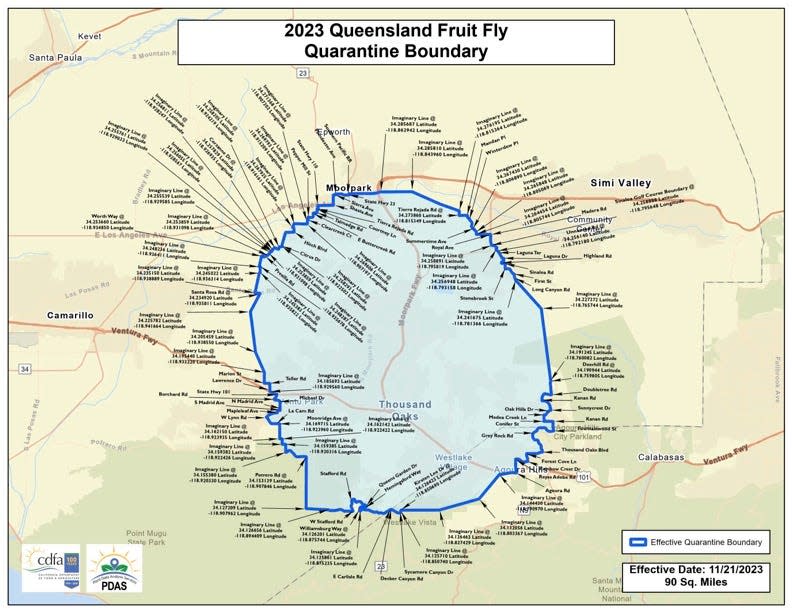State expands quarantine to stop spread of invasive fruit fly in Thousand Oaks area
State officials have widened a local quarantine area after a third Queensland fruit fly was discovered near Thousand Oaks.
The quarantine — put in place to control its spread until the invasive insect can be eradicated — now stretches roughly 90 square miles in Ventura and Los Angeles counties and could last into the summer. Growers in the area face strict rules and residents are urged not to move homegrown fruits and vegetables from their properties.
The insect native to Australia targets dozens of fruit and vegetable crops, from strawberries to lemons. Female flies lay eggs that hatch into maggots and tunnel into the flesh of the fruit, according to the California Department of Food and Agriculture.
With 100-plus potential host plants, the fly is considered a major threat, said Hamutahl Cohen, an entomology advisor with UC Cooperative Extension in Ventura County.
“We are concerned because it is one of the most serious agricultural pests globally,” Cohen said. “We have seen it cause a lot of damage in other regions like in Australia.”

Quarantine zone expands
The insect was first detected in September in a residential neighborhood in Thousand Oaks. When a second fly was discovered in the area, the quarantine was put in place.
Queensland fruit flies were spotted in California as early as the 1980s. But this was the first Queensland quarantine in the western hemisphere, state officials said.
The quarantine was expanded last month after a third fly was found. Dozens of farms are now affected, said Korinne Bell, the county's agricultural commissioner.
Growers in the quarantine area have to treat their crops but also may have to keep them on hold for roughly one lifecycle of the fly. In the winter, that can mean holding a crop for around 90 days, which officials said can lead to big losses.
Where is the quarantine?
Statewide, a record 600 exotic fruit flies have been detected in 2023. An average year has 75.
Factors such as an increase in travel and global commerce after pandemic restrictions lifted and the weather may have contributed to the rise, officials said. Fruit flies like wet, humid conditions and the area had a tropical storm and warm temperatures this summer.
The Queensland quarantine now stretches north to south roughly from the Southern Pacific railroad tracks near Highway 23 in Moorpark to the Las Virgenes Reservoir, and east to west from Agoura Hills to the Santa Rosa Valley. The area increased about 14 square miles from the initial zone.
To stop the spread of the fly, officials say they need the public's help.
What happens in the quarantine area?
Officials urged residents in the quarantine zone not to move any fruits or vegetables from their property.
The produce can be consumed or processed where it is picked. But if it is not consumed, officials asked that the fruit or vegetables be double bagged in plastic and put in a garbage bin, not one intended for green waste.
Within a smaller boundary — roughly 200 meters of where a fruit fly was found — the California Department of Food and Agriculture will visit properties and let people know about the quarantine. Staff also may schedule a time to treat some areas with an organic-approved pesticide called Spinosad, the department said.
People may not realize that fruit or vegetables from their yard are infested, Cohen said. It can take some time for the hard-to-spot eggs to hatch into maggots. The concern is that if they share fruit or vegetables, then a person outside the area may throw them away after finding them rotten inside.
“All of a sudden, there’s a fruit fly in their neighborhood as well,” she said.
How long will the quarantine last?
The quarantine could remain in effect into July, Bell said. That's the estimated length of time for three life cycles of the fly.
How long each cycle takes varies throughout the year. In the summer, it is roughly four weeks. But in the winter, it can take months. Right now, one lifecycle takes around 90 days, according to Cohen.
More information and an interactive map of the quarantine area is available at cdfa.ca.gov/plant/qff/regulation.html. Residents also may call the state's pest hotline at 1-800-491-1899.
Cheri Carlson covers the environment and county government for the Ventura County Star. Reach her at cheri.carlson@vcstar.com or 805-437-0260.
This article originally appeared on Ventura County Star: Thousand Oaks quarantine zone for invasive fruit fly expands

